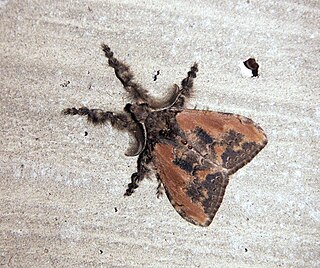
Olene mendosa, the brown tussock moth or hairy tussock moth, is a species of moth in the family Erebidae. The species was first described by Jacob Hübner in 1823. It is found in India, Bangladesh, Sri Lanka, Indonesia, Taiwan, Thailand and Australia.
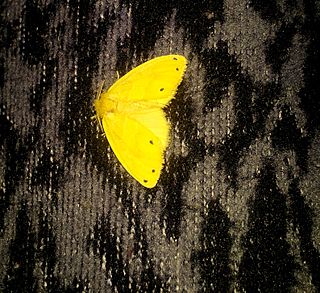
Artaxa is a genus of tussock moths in the family Erebidae erected by Francis Walker in 1855. Some of the species have urticating hairs.
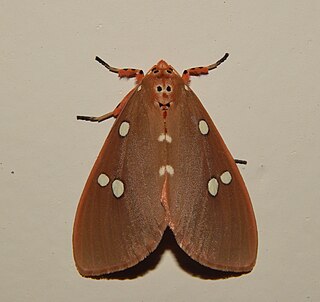
Tinolius eburneigutta is a moth of the family Erebidae first described by Francis Walker in 1855. It is found in India, Sri Lanka, and Thailand.
Themaca comparata is a moth of the family Erebidae first described by Francis Walker in 1865. It is found in India and Sri Lanka. It is sometimes placed in the genus Artaxa.
Artaxa digramma is a moth of the family Erebidae first described by Jean Baptiste Boisduval in 1844. It is found in India, Sri Lanka, Myanmar, Nepal, Java, Borneo, and recently China.
Artaxa vitellina is a moth of the family Erebidae first described by Vincenz Kollar in 1848. It is found in India and Sri Lanka.
Bembina apicalis is a moth of the family Erebidae first described by Francis Walker in 1865. It is found in India and Sri Lanka.
Sphrageidus xanthorrhoea is a moth of the family Erebidae first described by Vincenz Kollar in 1848. It is found in India, Sri Lanka, Java and Indonesia. It was once classified under the genus Euproctis, where it is accepted by some authors.
Euproctis fraterna is a moth of the family Erebidae first described by Frederic Moore in 1883. It is found in the Maldives, India, Sri Lanka and the Seychelles.
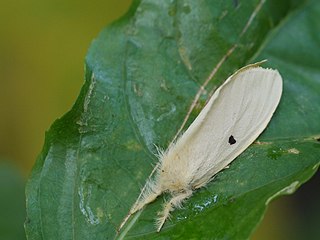
Euproctis lunata, the castor hairy caterpillar, is a moth of the family Erebidae. The species was first described by Francis Walker in 1855. It is found in India, Pakistan, Sri Lanka and Thailand.

Euproctis latifascia is a moth of the family Erebidae first described by Francis Walker in 1855. It is found in India, Sri Lanka and Taiwan.
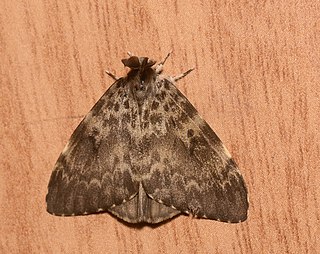
Lymantria ampla is a moth of the family Erebidae first described by Francis Walker in 1855. It is found in India and Sri Lanka.
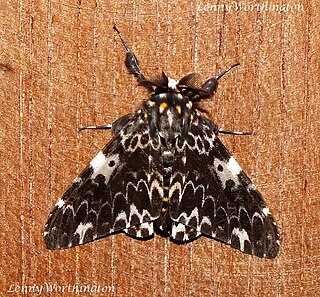
Lymantria marginata is a moth of the family Erebidae first described by Francis Walker in 1855. It is found in India, Bangladesh, Sri Lanka and Thailand.
Lymantria subrosea is a moth of the family Erebidae first described by Francis Walker in 1855. It is found from Sri Lanka to China and Sundaland, the Philippines, Sulawesi, Seram, the Lesser Sundas to Timor. The Sumatran population is categorized under the subspecies, Lymantria subrosea singapura.

Lymantria todara is a moth of the family Erebidae first described by Frederic Moore in 1879. It is found in India (Nilgiri) and Sri Lanka.
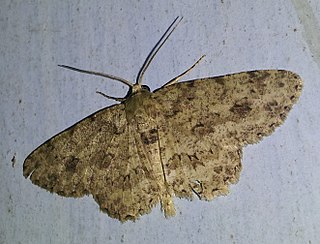
Ectropis bhurmitra, the tea twig caterpillar, is a moth of the family Geometridae. The species was first described by Francis Walker in 1860. A widespread Asian species, it is found around Indo-Australian tropics from India, Sri Lanka and Hong Kong, Taiwan, Thailand, New Guinea to Australian Queensland and the Solomon Islands.
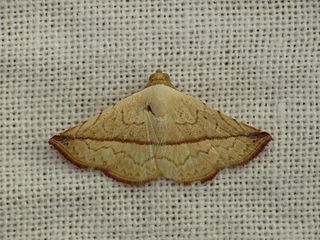
Autoba versicolor, the flower webber, sometimes included in the genus Eublemma, is a species of moth of the family Erebidae. It was described by Francis Walker in 1863, from material collected by Alfred Russel Wallace in Sarawak on the island of Borneo. It is the type species of its genus.
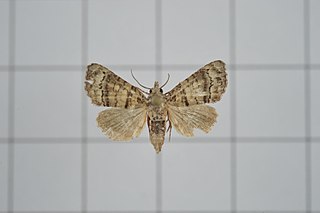
Chlumetia transversa, the mango shoot borer, is a moth of the family Euteliidae. The species was first described by Francis Walker in 1863. It is a widely distributed across Indo-Australian tropical countries far east to Solomon Islands.

Parasa bicolor, the green rice moth, is a moth of the family Limacodidae. The species was first described by Francis Walker in 1855. It is found in Sri Lanka, India, Nepal, Pakistan, Myanmar, Laos, Taiwan, Vietnam, Malaysia, Java, China and Taiwan.

Pammene critica, the redgram webber or leaf webber, is a moth of the family Tortricidae. The species was first described by Edward Meyrick in 1905. It is found in India and Sri Lanka.












